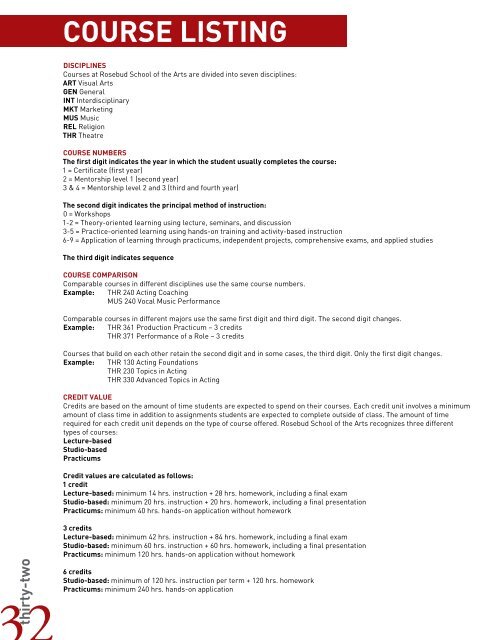Mentorship - Rosebud School of the Arts
Mentorship - Rosebud School of the Arts
Mentorship - Rosebud School of the Arts
You also want an ePaper? Increase the reach of your titles
YUMPU automatically turns print PDFs into web optimized ePapers that Google loves.
thirty-two<br />
COURSE LISTING<br />
DISCIPLINES<br />
Courses at <strong>Rosebud</strong> <strong>School</strong> <strong>of</strong> <strong>the</strong> <strong>Arts</strong> are divided into seven disciplines:<br />
ART Visual <strong>Arts</strong><br />
GEN General<br />
INT Interdisciplinary<br />
MKT Marketing<br />
MUS Music<br />
REL Religion<br />
THR Theatre<br />
COURSE NUMBERS<br />
The first digit indicates <strong>the</strong> year in which <strong>the</strong> student usually completes <strong>the</strong> course:<br />
1 = Certificate (first year)<br />
2 = <strong>Mentorship</strong> level 1 (second year)<br />
3 & 4 = <strong>Mentorship</strong> level 2 and 3 (third and fourth year)<br />
The second digit indicates <strong>the</strong> principal method <strong>of</strong> instruction:<br />
0 = Workshops<br />
1-2 = Theory-oriented learning using lecture, seminars, and discussion<br />
3-5 = Practice-oriented learning using hands-on training and activity-based instruction<br />
6-9 = Application <strong>of</strong> learning through practicums, independent projects, comprehensive exams, and applied studies<br />
The third digit indicates sequence<br />
COURSE COMPARISON<br />
Comparable courses in different disciplines use <strong>the</strong> same course numbers.<br />
Example: THR 240 Acting Coaching<br />
MUS 240 Vocal Music Performance<br />
Comparable courses in different majors use <strong>the</strong> same first digit and third digit. The second digit changes.<br />
Example: THR 361 Production Practicum – 3 credits<br />
THR 371 Performance <strong>of</strong> a Role – 3 credits<br />
Courses that build on each o<strong>the</strong>r retain <strong>the</strong> second digit and in some cases, <strong>the</strong> third digit. Only <strong>the</strong> first digit changes.<br />
Example: THR 130 Acting Foundations<br />
THR 230 Topics in Acting<br />
THR 330 Advanced Topics in Acting<br />
CREDIT VALUE<br />
Credits are based on <strong>the</strong> amount <strong>of</strong> time students are expected to spend on <strong>the</strong>ir courses. Each credit unit involves a minimum<br />
amount <strong>of</strong> class time in addition to assignments students are expected to complete outside <strong>of</strong> class. The amount <strong>of</strong> time<br />
required for each credit unit depends on <strong>the</strong> type <strong>of</strong> course <strong>of</strong>fered. <strong>Rosebud</strong> <strong>School</strong> <strong>of</strong> <strong>the</strong> <strong>Arts</strong> recognizes three different<br />
types <strong>of</strong> courses:<br />
Lecture-based<br />
Studio-based<br />
Practicums<br />
Credit values are calculated as follows:<br />
1 credit<br />
Lecture-based: minimum 14 hrs. instruction + 28 hrs. homework, including a final exam<br />
Studio-based: minimum 20 hrs. instruction + 20 hrs. homework, including a final presentation<br />
Practicums: minimum 40 hrs. hands-on application without homework<br />
3 credits<br />
Lecture-based: minimum 42 hrs. instruction + 84 hrs. homework, including a final exam<br />
Studio-based: minimum 60 hrs. instruction + 60 hrs. homework, including a final presentation<br />
Practicums: minimum 120 hrs. hands-on application without homework<br />
6 credits<br />
Studio-based: minimum <strong>of</strong> 120 hrs. instruction per term + 120 hrs. homework<br />
Practicums: minimum 240 hrs. hands-on application


